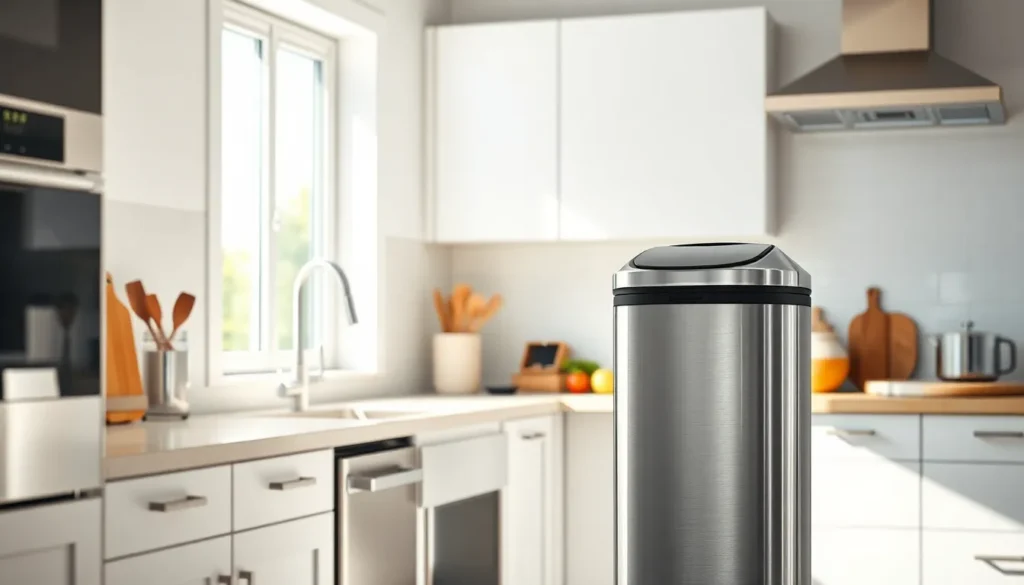We’ve all been there – standing in our kitchen wondering why our trash can situation feels like such a disaster. Whether it’s an overflowing bin that’s become an eyesore or a flimsy container that can’t handle daily kitchen chaos, the wrong trash can setup can make cooking and cleaning feel more stressful than it should be.
The truth is, your kitchen trash can isn’t just about waste disposal – it’s a crucial element that affects your kitchen’s functionality, cleanliness, and overall aesthetic. From sleek pull-out systems that hide seamlessly in your cabinetry to stylish step-on cans that complement your décor, the right choice can transform how you experience your kitchen space.
We’re here to guide you through the best kitchen trash can ideas that’ll solve your waste management woes while improving your kitchen’s design. Let’s explore answers that work for every kitchen size, style, and budget.
Choose the Right Size Kitchen Trash Can for Your Space
Selecting the perfect kitchen trash can size involves balancing your available space with your family’s waste disposal needs. We’ll walk you through the key measurements and considerations to find your ideal match.
Measure Your Available Space
Start by measuring the exact dimensions where you plan to place your kitchen trash can. We recommend measuring height, width, and depth of cabinets, corners, or designated floor areas to ensure a proper fit.
Account for clearance space around the trash can for easy access and lid operation. Most pull-out models need at least 2-3 inches of additional depth beyond the can itself, while step-on models require floor space for foot placement.
Consider door swing patterns and drawer openings that might interfere with your trash can placement. We’ve found that many homeowners overlook these functional clearances and end up with cans that block cabinet access or create workflow disruptions.
Consider Your Household Size
Single person households typically generate 2-3 bags of trash per week and work well with 8-13 gallon kitchen trash cans. These smaller capacities prevent odors from developing and match the lighter waste production.
Families of 2-4 people usually need 13-16 gallon trash cans to handle their weekly waste without frequent emptying. We recommend this size range for most standard kitchens as it balances capacity with manageable bag changes.
Large families with 5+ members benefit from 20+ gallon kitchen trash cans or dual-bin systems. These households often generate important food waste and packaging materials that require larger capacity answers.
Match Capacity to Usage Patterns
Heavy cooking households that prepare most meals at home need larger capacity trash cans to handle food scraps, packaging, and preparation waste. We suggest 16-20 gallon models for families who cook frequently and generate substantial organic waste.
Entertaining-focused kitchens require extra capacity during gatherings and parties when waste production spikes dramatically. Consider expandable or dual-compartment systems that accommodate both regular use and special occasions.
Recycling-conscious homes can often use smaller main trash cans when they separate recyclables and compostables effectively. We’ve observed that dedicated recycling systems can reduce main trash volume by 30-50%, allowing for more compact kitchen trash can options.
Select the Perfect Kitchen Trash Can Style
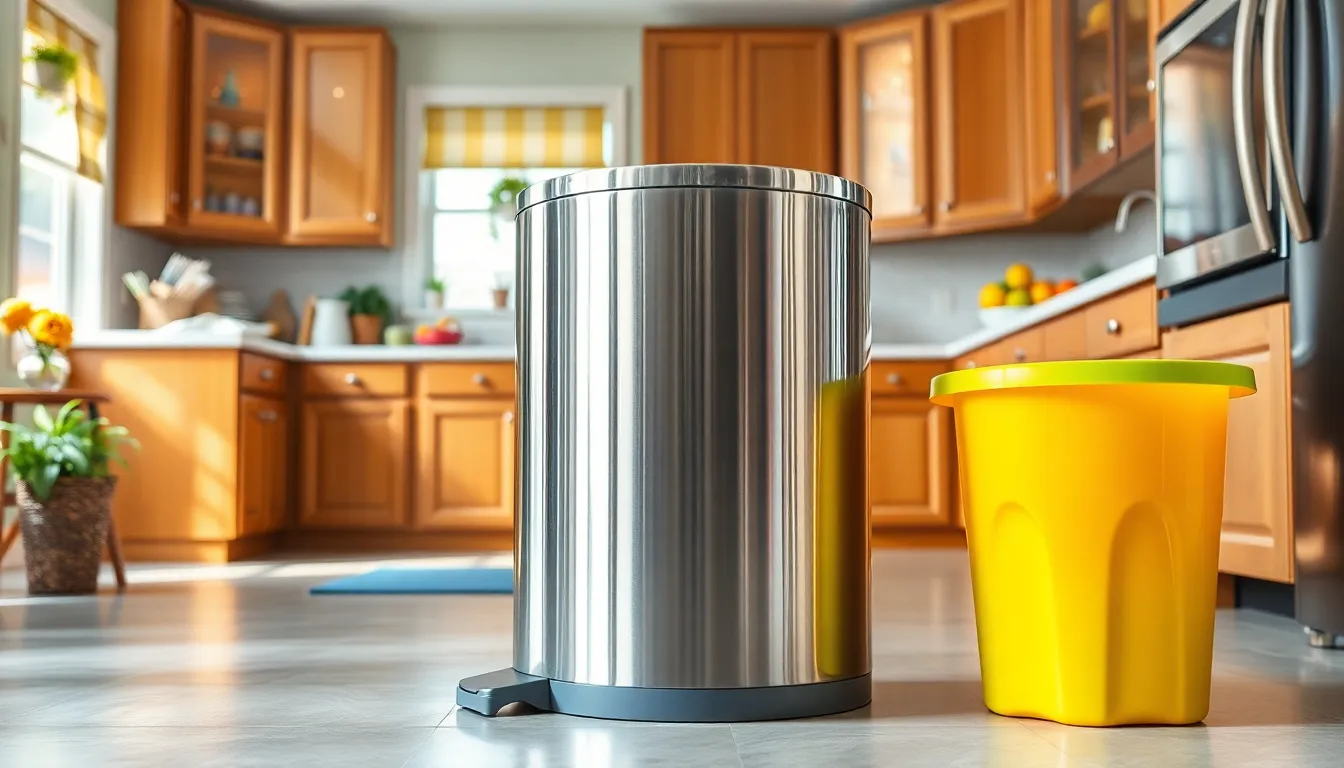
Your kitchen’s aesthetic and functional needs will guide you toward the ideal trash can style. We’ll explore three popular design categories that offer distinct advantages for different kitchen environments.
Modern Stainless Steel Options
Stainless steel trash cans deliver unmatched durability and sleek visual appeal for contemporary kitchens. These models feature fingerprint and smudge resistant finishes that maintain their polished appearance even in busy cooking spaces. Step on pedals provide hands free operation while you’re handling food or washing dishes. Soft close lids minimize noise and contain odors effectively during meal preparation.
Capacity options typically range from 6 to 13 gallon sizes to accommodate various household needs. A standard 13 gallon stainless steel model measures approximately 16 x 11.4 x 25.3 inches, fitting comfortably in most kitchen layouts. Dual bin models separate recycling from regular trash, streamlining your waste management routine. Cleaning becomes effortless with stainless steel’s non porous surface that resists stains and bacteria buildup.
Classic Plastic Designs
Plastic trash cans offer lightweight portability and budget friendly pricing for practical kitchen answers. These models include step on pedals for convenient hands free access and tight fitting lids that control unwanted odors. Wide, stable bases prevent accidental tipping when the can is full or during regular use.
Size availability spans multiple capacities, with a typical 13 gallon plastic model measuring around 18.7 x 14.4 x 26.2 inches. Custom liners enhance cleanliness and simplify bag changes during your daily kitchen routine. Easy cleaning features make maintenance straightforward, though durability may not match stainless steel options over extended periods. Color variety allows coordination with existing kitchen décor and personal style preferences.
Vintage and Retro Styles
Vintage style kitchen trash cans incorporate mid century design elements like rounded edges and metallic finishes for distinctive character. These models often feature playful colors that complement retro or eclectic kitchen themes. Design focus emphasizes aesthetic appeal over advanced functionality, creating conversation pieces that enhance your kitchen’s personality.
Availability includes both rectangular and round shapes to suit different kitchen layouts and spatial requirements. While these styles may not include modern features like automatic sensors or dual compartments, they remain popular choices for homeowners seeking unique visual impact. Blending capability with retro or eclectic décor makes vintage styles ideal for kitchens that prioritize character over cutting edge convenience features.
Explore Smart Kitchen Trash Can Features
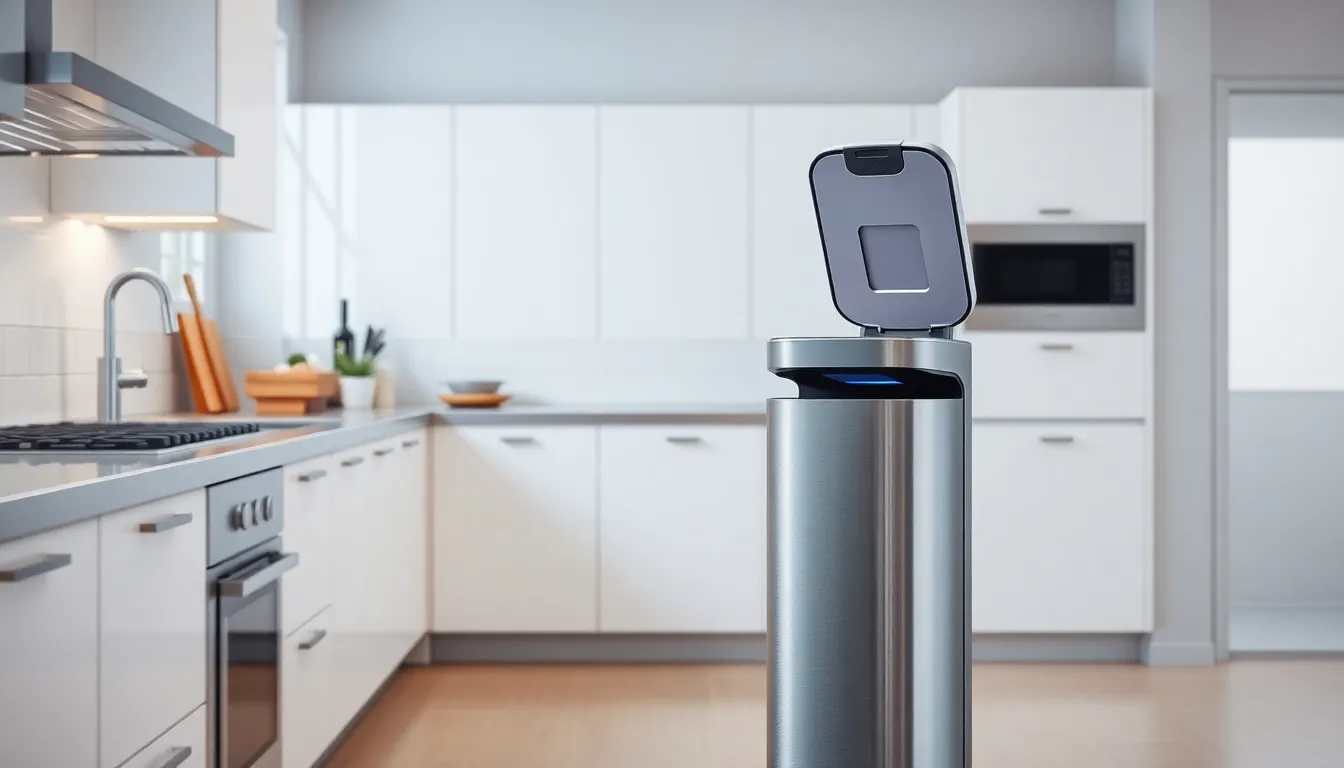
Smart technology transforms ordinary kitchen trash cans into sophisticated waste management systems. These innovative features streamline daily kitchen tasks while maintaining cleanliness and convenience.
Motion Sensor Lids
Motion sensor lids represent the pinnacle of touchless kitchen convenience. These advanced systems use infrared or ultrasonic sensors that detect approaching hands or waste items, automatically opening the lid for effortless disposal. We love how this technology eliminates the need to touch potentially contaminated surfaces, especially when our hands are messy from cooking or full of waste.
The sensors respond instantly to movement within their detection range, ensuring smooth operation during busy meal preparation. Most models feature adjustable sensitivity settings that prevent false triggering while maintaining reliable performance. When not in use, the lid remains securely closed to contain odors and prevent pests from accessing your waste.
Soft-Close Mechanisms
Soft-close mechanisms deliver whisper quiet operation that transforms your kitchen experience. These engineered systems ensure the trash can lid closes gently and smoothly after every use, eliminating the jarring slam that disrupts kitchen tranquility. We appreciate how this technology extends the product’s lifespan by reducing wear and tear from repeated impact.
The controlled closing action proves particularly beneficial in busy kitchens where frequent use can cause standard lids to deteriorate quickly. Premium models incorporate hydraulic or pneumatic systems that provide consistent performance over thousands of cycles. Families with young children especially value the quiet operation during early morning or late evening kitchen activities.
Odor Control Technology
Odor control technology tackles one of the most persistent kitchen challenges with innovative answers. These systems typically feature activated carbon filters that absorb and neutralize unpleasant smells before they escape into your kitchen environment. We’ve seen antimicrobial coatings that prevent bacteria growth while sealed bag systems trap odors at their source.
The smart trash bin market projects notable growth for odor control segments, reflecting consumer demand for fresher kitchen environments. Many models offer easy replacement or refreshment options for their odor controlling components, ensuring long term effectiveness. Advanced systems combine multiple technologies, including UV sanitization and air purification, to maintain optimal freshness between waste collections.
Find the Ideal Kitchen Trash Can Placement
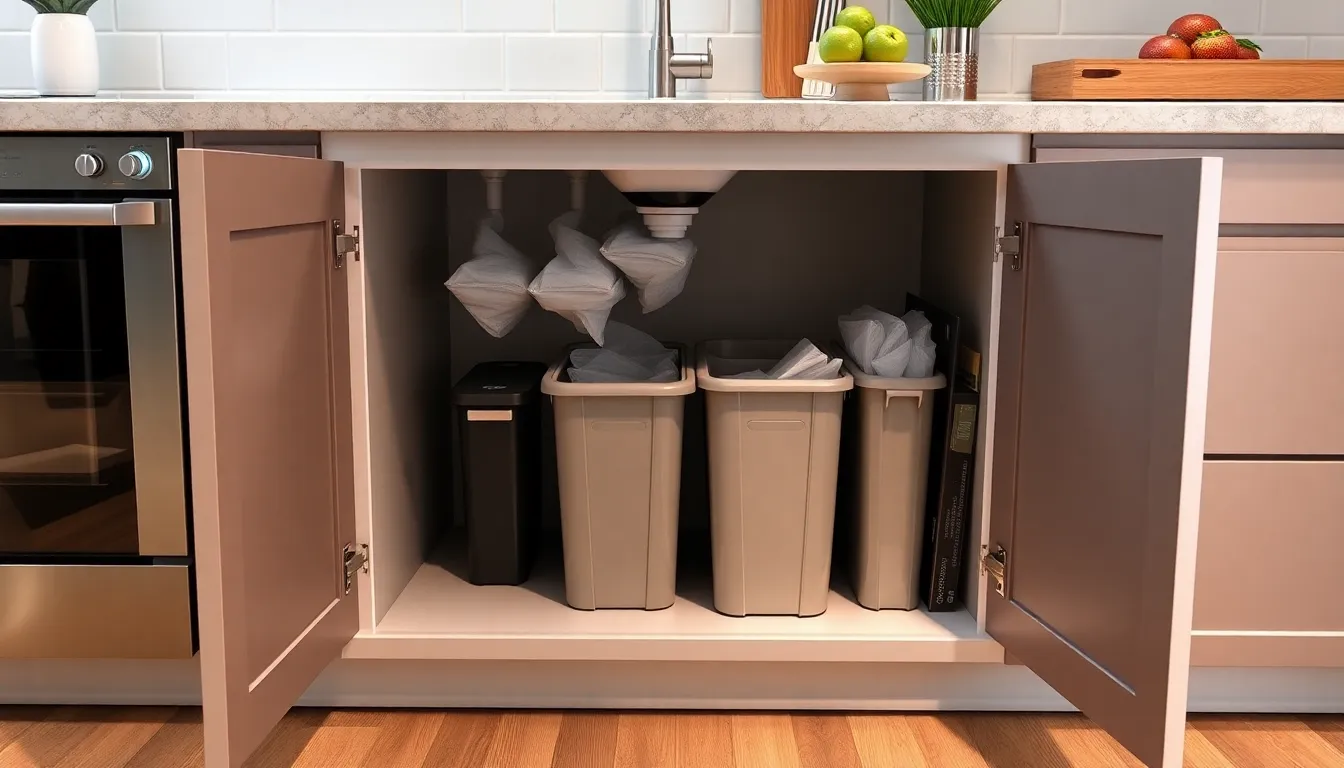
We’ve covered the features that make a great kitchen trash can, but placement is equally crucial for maximizing functionality and maintaining your kitchen’s aesthetic appeal. Strategic positioning near the sink and dishwasher creates the most efficient waste management workflow.
Under-Sink Installation Ideas
Under sink storage maximizes every inch of cabinet space while keeping your trash can completely hidden from view. We recommend hanging your bin on the inside of a cabinet door beneath the sink, which frees up valuable floor space and reduces odors by containing them within the cabinet.
Choose bins with secure lids to maintain hygiene and prevent pest problems in this enclosed environment. The under sink location provides easy access during food prep and cleanup while keeping waste containers out of sight.
Consider models with additional storage compartments for trash bags and odor eliminators to create a complete waste management system. This approach works particularly well in smaller kitchens where every square foot matters.
Cabinet Integration Answers
Pull out drawers offer the ultimate in concealed waste management for homeowners who want seamless kitchen design. These systems slide smoothly on tracks and can accommodate divided bins for trash, recycling, and compost in a single convenient location.
Tilt out trash cabinets provide sleek storage answers that blend perfectly with your existing cabinetry. Available in materials like stainless steel or wood, these units can match your kitchen decor while offering extra storage space above the trash compartment.
Install cabinet integration systems in high traffic areas near your primary food prep zone for maximum efficiency. We find that placing these systems between the sink and cooking area creates the most practical workflow for daily kitchen tasks.
Freestanding Corner Placement
Corner placement keeps freestanding bins accessible yet unobtrusive in kitchens where built in answers aren’t feasible. We suggest choosing decorative containers that complement your kitchen’s style rather than clash with your design scheme.
Position freestanding cans away from high traffic zones to prevent accidents while maintaining easy access for daily use. Corner spots typically offer the best balance of convenience and space efficiency.
Select bins with weighted bases or non slip bottoms to prevent tipping during use, especially in busy household kitchens. This placement strategy works best when you can’t modify existing cabinetry but still want organized waste management.
Discover Multi-Compartment Kitchen Trash Can Solutions
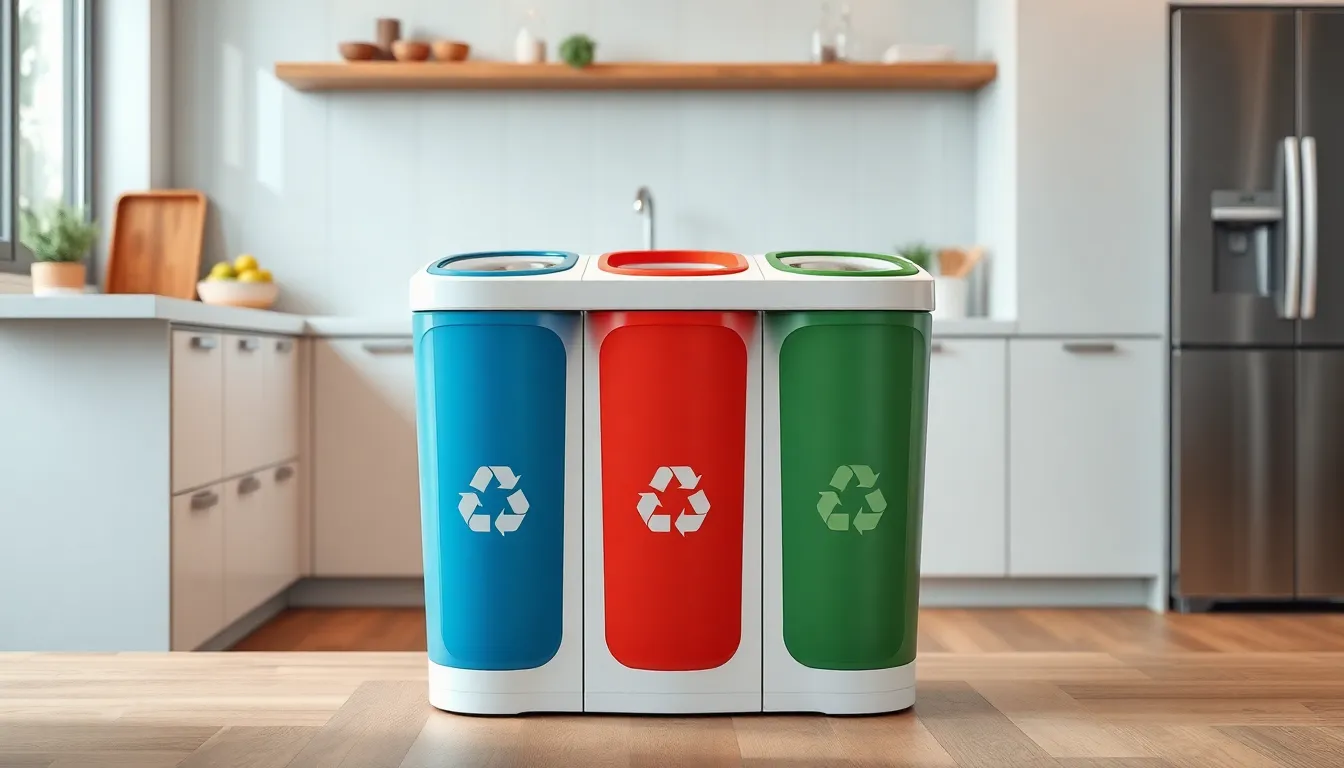
Multi-compartment kitchen trash cans revolutionize waste management by providing separate bins for trash, recycling, and compost in one convenient unit. These efficient systems streamline household waste sorting while encouraging sustainable practices that benefit both your kitchen organization and environmental impact.
Recycling and Waste Separation
Dual compartment bins feature two sections that simplify waste separation with removable inner buckets for effortless cleaning and transport. Popular configurations include 8-gallon compartments totaling 16 gallons or larger 16-gallon sections reaching up to 60 liters total capacity. Leading brands like Joseph Joseph and Brabantia offer diverse styles including pull-out drawers, step-on mechanisms, and touch-top models that cater to different kitchen layouts.
Removable inner buckets provide leak-proof convenience for emptying and washing individual compartments without moving the entire unit. These portable containers allow you to transport recyclables directly to outdoor bins while maintaining hygiene in your kitchen space. Most models feature sturdy handles and smooth surfaces that resist staining and odor absorption.
Multiple size options accommodate households ranging from compact apartments to large family kitchens with capacities spanning 16 to 60 liters total. Smaller units work perfectly for minimal waste producers while larger configurations handle busy cooking environments and frequent entertaining needs.
Compost Integration Options
Third compartment designs include dedicated sections for compostable materials that often come lined with biodegradable bags for easy disposal. These specialized compartments encourage organic waste separation while maintaining organization within your existing kitchen footprint. Integrated compost sections typically range from 2 to 4 gallons depending on overall unit size.
Odor control features incorporate charcoal filters and sealed lids that minimize unpleasant smells and reduce pest attraction in compost compartments. Advanced models use antimicrobial coatings that prevent bacterial growth while maintaining freshness throughout the week. Some units include removable filter cartridges that require replacement every 3 to 6 months for optimal performance.
Ventilation systems allow proper airflow in compost sections while containing odors through strategically placed vents and filtering mechanisms. These designs promote healthy decomposition processes without compromising kitchen air quality or attracting unwanted insects.
Color-Coded Sorting Systems
Visual sorting answers use different colored compartments like black for trash, blue for recycling, and green for compost that simplify identification and encourage proper waste separation. These intuitive color schemes follow universal recycling standards that family members and guests can easily recognize and follow. Most manufacturers offer customizable color combinations to match your kitchen décor preferences.
Integrated labeling systems feature clear icons and text above each compartment that provide guidance on appropriate waste categories for each section. These permanent labels resist fading and wear while maintaining visibility even in low-light conditions. Some models include multilingual options or pictorial symbols that accommodate diverse household needs.
Educational benefits help children and adults develop consistent sorting habits through clear visual cues and organized waste management systems. Color-coded bins reduce contamination between waste streams while supporting recycling program requirements in your community. These systems typically increase household recycling rates by 25 to 40% according to waste management studies.
Consider Space-Saving Kitchen Trash Can Designs
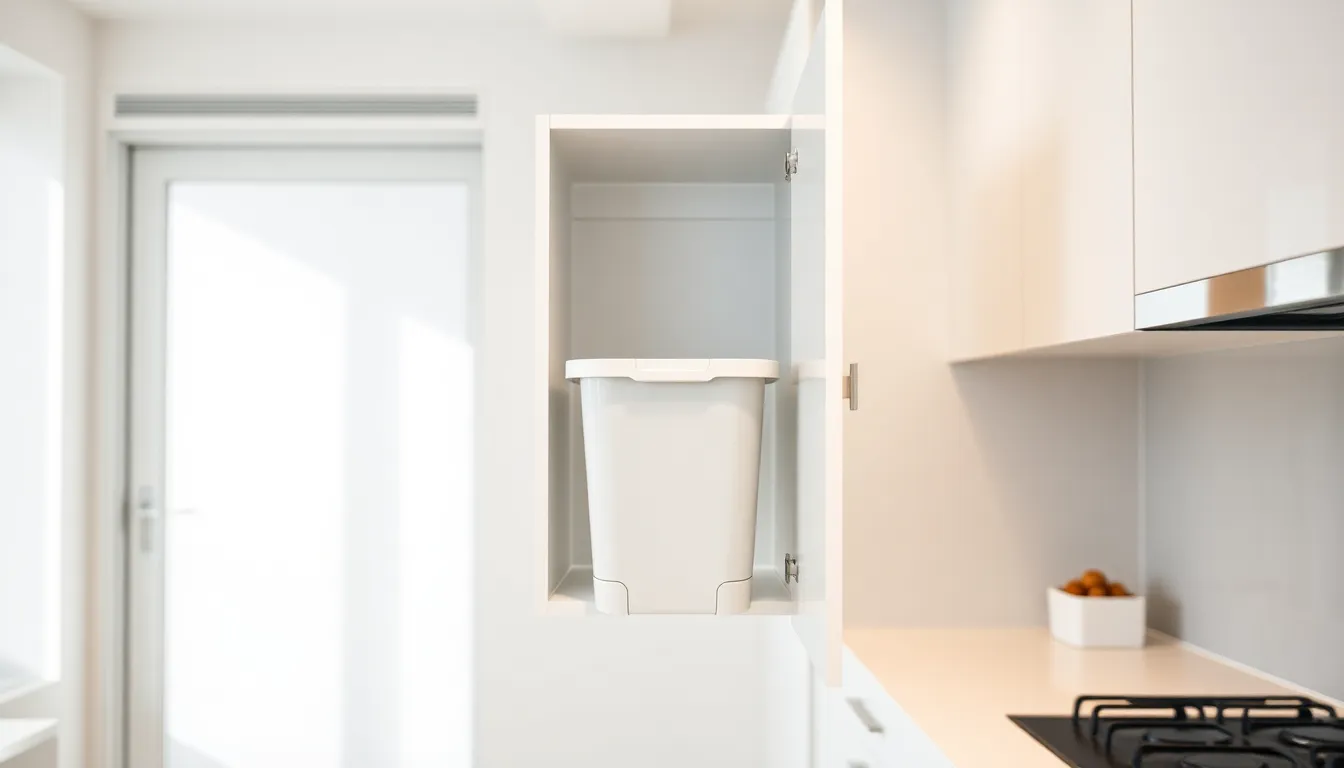
When floor space becomes precious in your kitchen, we need to explore creative answers that maximize functionality without sacrificing style. Space-saving trash can designs excel in compact kitchens, apartments, and RVs where every square inch matters.
Pull-Out Drawer Systems
Pull-out drawer systems transform under-sink cabinetry into efficient waste management centers. These systems mount directly inside cabinet doors, keeping trash receptacles completely out of sight while freeing up valuable floor space. We recommend dual bin versions that separate trash from recycling in a single drawer system, streamlining your sorting process.
Installation requires minimal cabinet modification, and most systems integrate smoothly with existing cabinetry hardware. The pull-out mechanism allows full access to bins without bending or reaching, making waste disposal more comfortable. Single bin options work well for smaller households, while dual compartment systems accommodate families with higher waste volume.
Cabinet door mounting keeps unsightly trash bins hidden from view, maintaining your kitchen’s clean aesthetic. The smooth-sliding drawer action ensures quiet operation, and most models include mounting brackets that distribute weight evenly across cabinet frames.
Wall-Mounted Options
Wall-mounted trash cans attach directly to cabinet sides, walls, or inside cabinet doors for ultimate space efficiency. These units eliminate the need for floor space entirely, positioning at convenient heights for easy access. We’ve found that mounting inside cabinet doors creates the most discreet solution while maintaining full functionality.
Various capacity options accommodate different household sizes, from compact 2-gallon models to larger 13-gallon versions. The adjustable mounting height allows customization for optimal ergonomics, reducing strain during daily use. Cabinet-side mounting works particularly well in galley kitchens where floor space is extremely limited.
Installation typically requires basic hardware and takes less than 30 minutes for most models. The removable bin design simplifies emptying and cleaning, while secure mounting systems prevent accidental detachment during regular use.
Compact Countertop Models
Compact countertop models excel in ultra-small kitchens where traditional floor bins won’t fit. These lightweight units measure under 12 inches wide, fitting seamlessly on countertops, islands, or in tight corners without overwhelming the space. Modern designs complement contemporary décor while providing essential waste management functionality.
Push-open lids offer hands-free operation, maintaining hygiene during food preparation. Odor control features include activated carbon filters that neutralize unpleasant smells, keeping your kitchen environment fresh. The small footprint doesn’t compromise capacity, with most models holding 3-5 gallons of waste.
Easy cleaning remains a priority in these designs, with removable inner buckets and smooth surfaces that wipe clean effortlessly. Whisper-close lids prevent slamming sounds, while side-grip handles ensure secure transport when emptying. These answers prove that limited space doesn’t mean compromising on waste management efficiency.
Maintain Your Kitchen Trash Can Properly
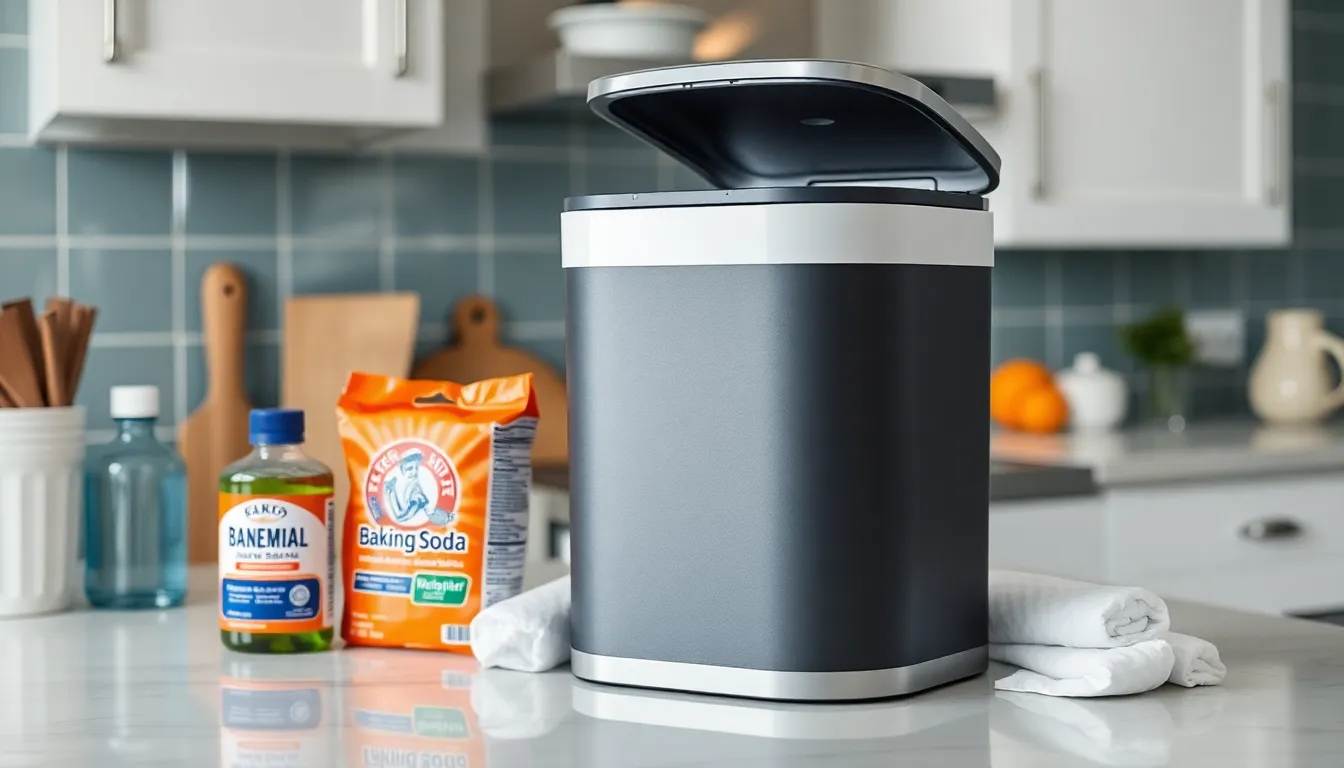
Proper maintenance keeps your kitchen trash can functioning efficiently while preventing unpleasant odors and bacterial buildup. We’ll guide you through essential care practices that extend your trash can’s lifespan and maintain kitchen hygiene.
Regular Cleaning Schedules
Clean your kitchen trash can at least twice yearly to prevent grime accumulation and persistent odors. Spring and fall cleanings align perfectly with seasonal deep cleaning routines.
Remove all debris first, then wipe down the bottom and interior sides thoroughly. We recommend washing the entire can with hot soapy water using diluted dish soap in a bathtub or large bucket for complete coverage.
Scrub all surfaces vigorously with a stiff brush or dedicated toilet brush, paying special attention to corners and crevices where residue accumulates. Stubborn stains require a baking soda paste treatment: mix baking soda with water, apply generously, and let sit for 10 minutes before scrubbing.
Disinfect using spray disinfectant or create a diluted bleach solution with 1/8 cup bleach per quart of water. Rinse thoroughly after disinfecting to remove all chemical residues.
Air dry completely outside in sunlight whenever possible before installing fresh liners. Complete drying prevents mold growth and eliminates moisture that attracts bacteria.
Liner and Bag Selection
Choose sturdy, properly sized liners that match your trash can’s dimensions to prevent tears and leakage. Thick plastic bags or biodegradable options provide superior containment compared to flimsy alternatives.
Consider scented or odor absorbing liners for enhanced freshness between regular cleanings. These specialized bags contain built in deodorizing agents that neutralize unpleasant smells.
Replace liners regularly regardless of fullness to prevent residue buildup and bacterial growth. Fresh liners every few days maintain optimal hygiene levels.
Select leak resistant materials that can handle wet waste without compromising. Double bagging particularly messy items provides extra protection for your trash can’s interior.
Odor Prevention Tips
Sprinkle baking soda generously at the bottom of your trash can or directly inside the bag before adding waste. This natural deodorizer absorbs odors continuously throughout the day.
Place odor neutralizing products such as activated charcoal or used coffee grounds inside the bin for ongoing freshness. These materials naturally eliminate unpleasant smells without chemical additives.
Avoid throwing wet food scraps directly into unlined bins, as moisture accelerates bacterial growth and intensifies odors. Always use properly fitted liners when disposing of food waste.
Ensure complete air drying after each cleaning session to prevent mold and mildew formation. Trapped moisture creates ideal conditions for odor causing bacteria to multiply rapidly.
Budget-Friendly Kitchen Trash Can Ideas
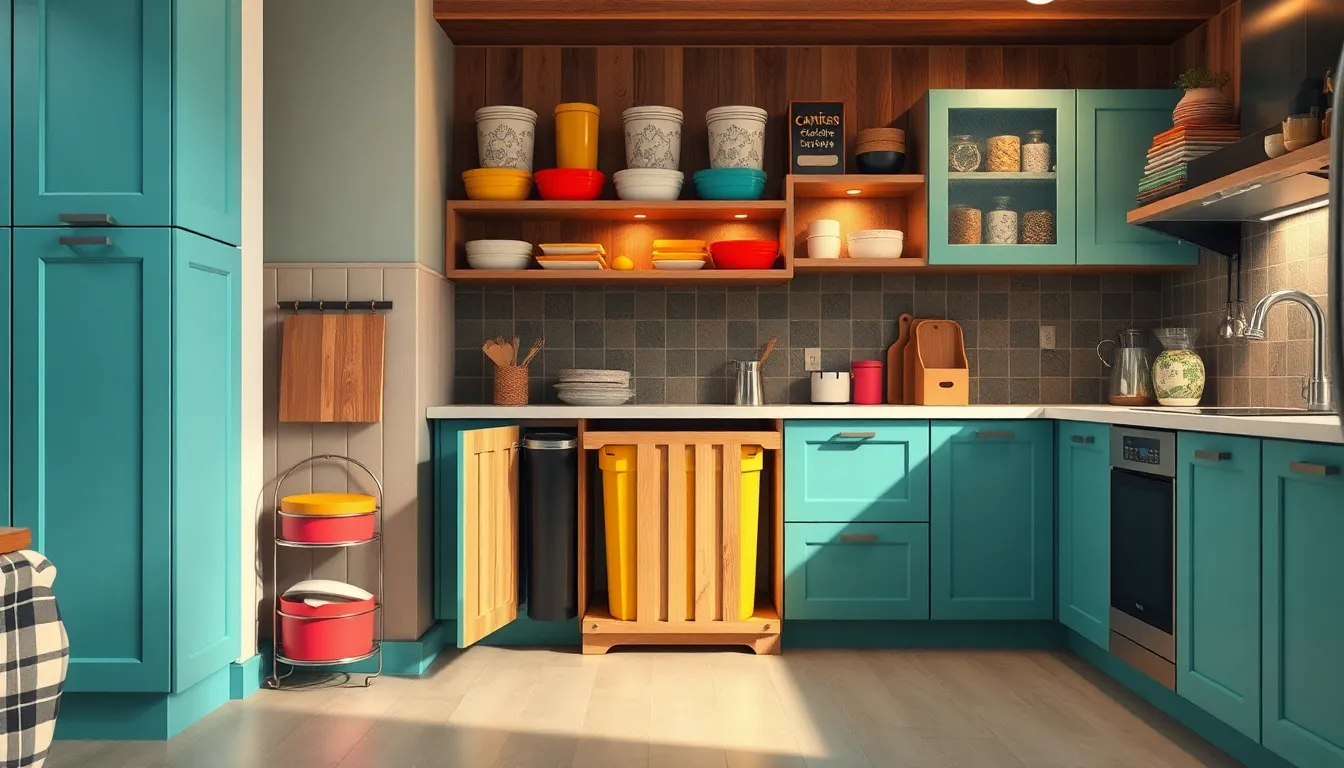
Transforming your kitchen waste management doesn’t require very costly. We’ve compiled practical answers that maximize both functionality and style while staying within tight budgets.
DIY Customization Projects
Building a trash can cabinet becomes an affordable option when you start with thrift store finds or basic wooden boxes. Transform old kitchen cabinets into stylish trash bin enclosures by adding hinged doors and ventilation holes. Convert storage containers or wooden crates into custom pull-out systems that slide smoothly under counters.
Painting existing bins offers instant visual upgrades for under $20. Use spray paint, vinyl decals, or contact paper to match your kitchen’s color scheme. Apply chalkboard paint to create writable surfaces for sorting labels or shopping lists.
Creating custom pull-out drawers maximizes cabinet space without major renovations. Install simple drawer slides inside existing cabinets to accommodate standard trash bins. Add wooden frames around plastic containers to create professional-looking built-in systems.
Upcycling household items provides creative alternatives to traditional trash cans. Large plastic storage boxes, old buckets, and even decorative woven baskets can serve as attractive waste receptacles. Line these containers with removable bags for easy cleaning and maintenance.
Affordable Brand Recommendations
Simplehuman plastic trash cans deliver durability and smooth pedal operation at lower price points than stainless steel models. These bins accommodate standard trash bags and feature reliable lid mechanisms that withstand daily use.
Basic plastic models from discount retailers provide essential functionality for under $30. Many include pedal lids, removable inner buckets, and secure bag-locking systems. Metal alternatives in this price range offer increased durability with similar features.
Stackable recycling bins help manage multiple waste streams affordably. Divided compartments allow separation of trash and recyclables in compact spaces. These systems typically cost 30-50% less than built-in cabinet answers.
Cost-Effective Upgrade Options
Adding odor control features improves any existing trash can’s performance. Place baking soda containers, activated charcoal pouches, or odor-absorbing gels inside bins to neutralize unpleasant smells. These answers cost under $10 and last several months.
Installing custom liners ensures better bag fit and reduces waste. Use elastic bands or drawstring systems to secure bags in non-standard containers. Create fitted covers from fabric remnants to hide unsightly bins while maintaining easy access.
Retrofitting cabinet space accommodates pull-out systems without full renovations. Add simple brackets or door-mounted bins to existing cabinetry. Install tilt-out mechanisms on cabinet doors to conceal small waste containers while preserving counter space.
Conclusion
Finding the perfect kitchen trash can doesn’t have to be overwhelming when you know what to look for. We’ve covered everything from sizing and style options to smart features and space-saving answers that can transform your waste management experience.
Whether you’re working with a compact apartment kitchen or designing a spacious culinary haven we believe there’s an ideal trash can solution for every home. The key is balancing your functional needs with your aesthetic preferences while staying within your budget.
Remember that a well-chosen kitchen trash can is an investment in your daily routine. With proper maintenance and the right features your trash can will serve you efficiently for years while keeping your kitchen clean organized and stylish.
Frequently Asked Questions
What size kitchen trash can do I need for my household?
The ideal size depends on your household size and cooking habits. Single-person households typically need 8-13 gallon cans, families of 2-4 people should consider 13-16 gallon options, and larger families require 20+ gallon capacity. Heavy cooking households benefit from larger cans, while homes that effectively separate recyclables and compostables can use smaller sizes.
Where should I place my kitchen trash can for optimal functionality?
Position your trash can near the sink and dishwasher for efficient waste management during food prep and cleanup. Under-sink installation keeps bins hidden and reduces odors, while cabinet integration with pull-out drawers provides seamless access. For kitchens without built-in options, stable corner placement works well with decorative bins.
What are the benefits of smart kitchen trash can features?
Smart features enhance convenience and hygiene. Motion sensor lids provide touchless operation, preventing contact with contaminated surfaces. Soft-close mechanisms operate quietly and extend the trash can’s lifespan. Odor control technology using activated carbon filters and antimicrobial coatings neutralizes unpleasant smells, maintaining a fresher kitchen environment.
Are multi-compartment trash cans worth the investment?
Yes, multi-compartment systems revolutionize waste management by providing separate bins for trash, recycling, and compost in one unit. They simplify waste separation, feature removable inner buckets for easy cleaning, and often include color-coded sorting systems that promote proper waste separation habits while saving space.
How often should I clean my kitchen trash can?
Clean your kitchen trash can at least twice a year for optimal hygiene. Remove all debris, scrub with hot soapy water, and disinfect with bleach solutions. For high-use households or during summer months, consider more frequent cleaning. Regular maintenance prevents grime buildup, eliminates odors, and prevents bacterial growth.
Can I find quality kitchen trash cans on a budget?
Absolutely! Budget-friendly options include durable plastic models, stackable recycling bins, and DIY customization projects. Transform thrift store finds into stylish enclosures, paint existing bins for visual upgrades, or add cost-effective features like baking soda for odor control. Retrofitting cabinet space for pull-out systems is also affordable.
What’s the difference between stainless steel and plastic trash cans?
Stainless steel offers durability, sleek appearance, fingerprint-resistant finishes, and hands-free operation, making them ideal for modern kitchens. Plastic designs provide lightweight portability, budget-friendly pricing, and easy maintenance. Both materials can be effective; choose based on your kitchen style, budget, and durability requirements.
How do I prevent odors in my kitchen trash can?
Use sturdy liners to prevent leaks, sprinkle baking soda in the bottom of the can, and consider activated charcoal filters. Ensure proper ventilation, clean regularly with disinfectant, and empty frequently. Some trash cans feature built-in odor control technology with antimicrobial coatings for enhanced freshness.

